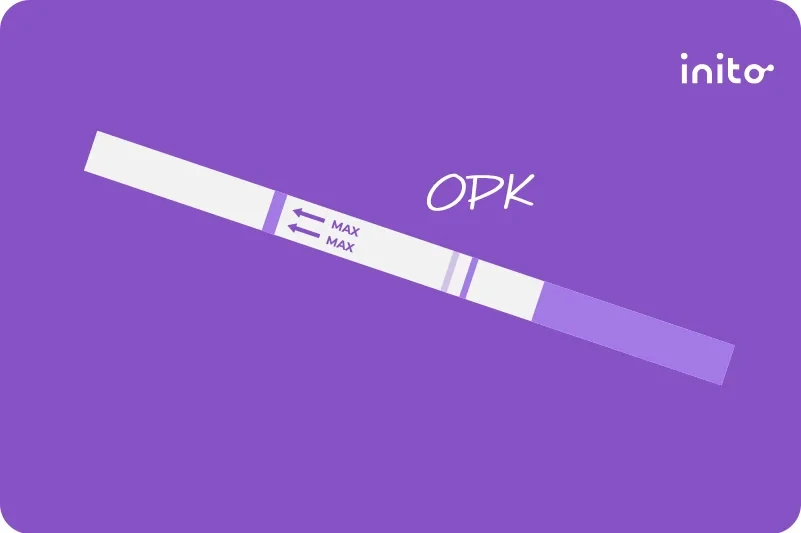Content table
Ovulation is when a mature egg is released from an ovary. This happens in the middle of your cycle, and it’s the time when you’re most likely to get pregnant. Within a normal cycle, this happens once. But is it possible to ovulate more than once in a cycle?
Let’s talk about it.
We’ve thought for a long time that ovulation can only happen once. New research suggests that this isn’t true, and we’ll discuss this later on. There is such a thing as releasing more than one egg at once, or hyperovulation.
What is hyperovulation?
In your cycle, you release an egg once. Within that ovulation, you can release more than one egg at a time. This is called hyperovulation.
Hyperovulation is not ovulating more than once. It means that when you ovulate, you’re releasing more than one mature egg. This can happen where one ovary releases more than one egg, or both ovaries release an egg at the same time.
Ovulating twice in a cycle: is it possible?

It might be. For a long time, we thought that it wasn’t possible to ovulate twice in one regular cycle. Some evidence suggests that this is possible, and it might happen more than we know.
But first, let’s get into the physiology of ovulation.
Before ovulating, several eggs mature inside the ovary. They’re each enclosed in a sac called a follicle. The first stage of your cycle is called the follicular stage because it’s when several eggs mature inside their own follicles.
In the middle of the follicular stage, the largest egg becomes the dominant follicle. This is the one that will be released during ovulation. While several follicles mature over the follicular stage, the extra ones die once the dominant one is chosen.
Towards the end of the follicular phase, the mature follicle releases estrogen. The brain picks up on this, and the pituitary gland releases Luteinizing Hormone (LH) in response. This LH surge is what causes the follicle to push itself out of the ovary and release the egg.
We used to think that only one follicle could fully mature each month. But research published in 2003 gave us surprising new insights into the cycle of ovulation.
In this study, researchers followed follicular growth using ultrasounds on women in their childbearing years.
They found that 68% of these women had two separate “waves” of follicle development, and almost a third had three waves.
This research tells us that for many women, several eggs are maturing for release each cycle. This does not mean that you’re ovulating several times. Instead, it means that more eggs could be released than we thought.
We’re hoping for more research on ovulation and the waves of follicular development so we can learn more about this important phase of fertility. But is it possible to release more than one egg during ovulation?
Causes of hyperovulation
Let’s understand how you may release more than one egg during each cycle.
- Fraternal twins:
If you are trying to figure how fraternal twins are born, then read on. In some women, two eggs mature at the same time and get released during ovulation.
Each ovary releases its mature egg. When the sperm fertilizes each of these eggs, you have fraternal twins (twins who do not look identical).There is a genetic component to fraternal twins, and they do run in families. Twins are rare but can be more likely for some women.
- Polycystic Ovary syndrome
Women with polycystic ovary syndrome (PCOS) often have hyperovulation. PCOS is a condition where a woman has higher levels of androgen hormones. These hormone imbalances make it harder for eggs to mature before ovulation. For some cycles, a woman with PCOS may not ovulate at all. But in the next cycle, she may release several eggs at once. - Ovulation induction:
Another scenario where you may have multiple eggs being released is during ovulation induction. Ovulation induction simply means that you are given certain medications to induce ovulation.
During an intrauterine insemination (IUI) procedure or an in vitro fertilization (IVF) procedure, your gynecologist will give medicines to improve your chances of ovulating.The more eggs being released during an IUI procedure, the better the chances of conceiving. After inducing ovulation, the partner’s semen is injected into your uterus. This gives the sperm higher chances of fertilizing the multiple eggs in the uterus.
During IVF, immature eggs are harvested from your ovaries. They mature outside of your body and then are injected into the uterus. These eggs are then injected into the uterus for fertilization. This makes it much more likely that several eggs will be fertilized to make twins or triplets or multiple babies.
After you ovulate, progesterone halts other eggs from maturing and being released. Hence you can only ovulate on your ovulation day and not multiple times in one cycle. During your ovulation day, you can release multiple eggs depending on the above reasons.
What happens if I release more than one egg during ovulation?
This probably happens more often than we realize. Not many women get ultrasounds at this stage in their cycle, so we don’t know how many eggs are released each ovulation.
But an egg has to be fertilized for pregnancy to begin. Unfertilized eggs are released along with the uterine lining during your period. But it’s possible for multiple eggs to release during ovulation, and to also be fertilized in the fallopian tubes.
Why is my home ovulation test saying I’m ovulating several times?
If you’re using standard ovulation testing, you may think you’re ovulating more than once in a cycle during your hyperovulation cycle when you’re actually not. This is why it’s so important to track four different fertility hormones to get the full picture of your cycle.
Standard fertility trackers tell you the levels of LH in your urine. Remember that the LH surge causes the follicle to release an egg from the ovary. Home ovulation tests aren’t actually telling you that you’re ovulating, they’re telling you that your body is trying to ovulate by producing LH.
But not every LH surge results in ovulation. In fact, some women may have several LH surges but not ovulate at all, or they have higher levels of LH all the time.
Learn More : LH Surge and Ovulation: When do you ovulate after an LH surge?
Up to 37% of cycles actually don’t result in egg release. This anovulation is the most common cause of infertility. There are a lot of reasons why a woman may not ovulate in a cycle. One of the most common reasons is stress, which inhibits specific hormones that cause ovulation.
Learn More : Anovulation: Everything you need to know about the #1 cause of infertility
But a standard fertility tracker won’t tell you whether or not you’ve ovulated. It could even tell you that you’re ovulating several times in a single cycle, when you haven’t actually released an egg at all due to the constant LH surges.
What can cause false-positive fertility tests?

False-positive tests happen when your LH is high enough to trigger the test, but ovulation doesn’t happen. There are many reasons why these false positives can happen, here are a few of them:
- Women with PCOS may have higher levels of LH throughout the month, or have several surges of LH. Many women with PCOS have these high LH levels without ovulating at all.
- Certain medicines that induce ovulation cause an increase in LH.
- Injected fertility treatments, like Menopur, have LH in them and can elevate LH levels in blood and urine.
- It’s possible to have several surges of LH, where your body is trying to ovulate but there is no mature egg to release. This is sometimes called Luteinizing Unruptured Follicle Syndrome.
- LH is very similar to hCG, the hormone that causes a positive pregnancy test. High levels of hCG can be caused by pregnancy and sometimes tumors.
The only way to definitively know whether you’ve ovulated or not is to track progesterone as well as FSH, LH, and estrogen. Progesterone and its metabolite PdG rise after ovulation because the now-empty follicle releases it into the bloodstream.
By getting the full picture of ovulation, you can know definitively whether or not you’ve ovulated. If your at-home fertility test is telling you that you’re ovulating over and over, try a more comprehensive fertility tracker like Inito. Inito measures your FSH, estrogen, LH, and PdG in urine to help you track your fertile window and confirm ovulation.
Summary:
- New research tells us it is possible to ovulate more than once in a cycle.
- It’s possible to release more than one egg per ovulation. This hyperovulation is what causes fraternal twins.
- Home fertility tests track LH, and can’t show you whether you’ve ovulated or not. There are several reasons why home fertility tests would show false-positives.
- If your home fertility test is telling you you’re ovulating over and over, it might be time to try inito.
Was this article helpful?
https://www.ncbi.nlm.nih.gov/pmc/articles/PMC1126506/
https://medlineplus.gov/genetics/understanding/traits/twins/https://www.fertstert.org/article/S0015-0282(03)00544-2/fulltext
https://www.ncbi.nlm.nih.gov/pmc/articles/PMC3773899/
https://americanpregnancy.org/getting-pregnant/infertility/ovulation-kits/#:~:text=Some%20women%20may%20have%20a,with%20the%20polycystic%20ovarian%20syndrome.
https://medlineplus.gov/ency/article/000369.htm
https://www.mayoclinic.org/tests-procedures/in-vitro-fertilization/about/pac-20384716











